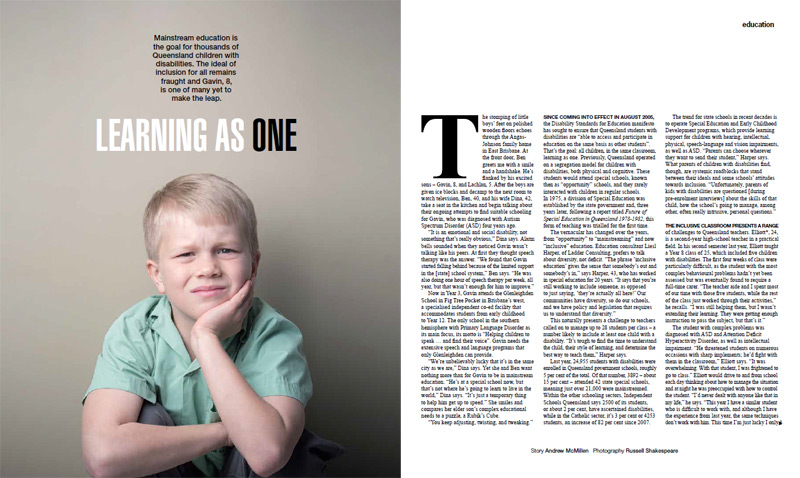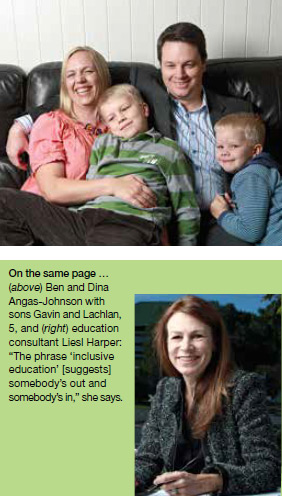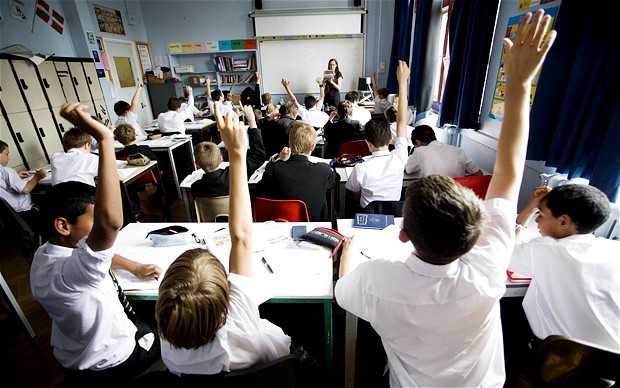Learning As One
Mainstream education is the goal for thousands of Queensland children with disabilities. The ideal of inclusion for all remains fraught and Gavin, 8, is one of many yet to make the leap.

Story Andrew McMillen / Photography Russell Shakespeare
The stomping of little boys’ feet on polished wooden floors echoes through the Angas-Johnson family home in East Brisbane. At the front door, Ben greets me with a smile and a handshake. He’s flanked by his excited sons – Gavin, 8, and Lachlan, 5. After the boys are given ice blocks and decamp to the next room to watch television, Ben, 40, and his wife Dina, 42, take a seat in the kitchen and begin talking about their ongoing attempts to find suitable schooling for Gavin, who was diagnosed with Autism Spectrum Disorder four years ago.
“It is an emotional and social disability, not something that’s really obvious,” Dina says. Alarm bells sounded when they noticed that Gavin wasn’t talking like his peers. At first they thought speech therapy was the answer. “We found that Gavin started falling behind because of the limited support in the [state] school system,” Ben says. “He was also doing one hour of speech therapy per week, all year, but that wasn’t enough for him to improve.”
Now in Year 3, Gavin attends The Glenleighden School in Fig Tree Pocket in Brisbane’s west, a specialised co-ed facility that accommodates students from early childhood to Year 12. Its motto is “Helping children to speak … and find their voice.” Gavin needs the extensive speech and language programs that only Glenleighden can provide.
“We’re unbelievably lucky that it’s in the same city as we are,” Dina says. Yet she and Ben want nothing more than for Gavin to be in mainstream education. “He’s going to a special school now, but that’s not where he’s going to learn to live in the world,” Dina says. “It’s just a temporary thing to help him get up to speed.” She smiles and compares her eldest son’s complex educational needs to a puzzle, a Rubik’s Cube.
“You keep adjusting, twisting, and tweaking.”
++
Since coming into effect in August 2005, the Disability Standards for Education manifesto has sought to ensure that Queensland students with disabilities are “able to access and participate in education on the same basis as other students”. That’s the goal: all children, in the same classroom, learning as one. Previously, Queensland operated on a segregation model for children with disabilities, both physical and cognitive. These students would attend special schools, known then as “opportunity” schools and they rarely interacted with children in regular schools. In 1975, a Division of Special Education was established by the State Government; three years later, following a report titled Future of Special Education in Queensland 1978-1982, this form of teaching was trialled in the state for the first time.
The vernacular surrounding special education has changed over the years, from “opportunity” to “mainstreaming” and now “inclusive” education. Education consultant Liesl Harper, of Ladder Consulting, prefers to talk about diversity, not deficit. “The phrase ‘inclusive education’ gives the sense that somebody’s out, and somebody’s in,” says Harper, 43, who has worked in the area of special education for 20 years. “It says that you’re still working to include someone, as opposed to just saying, ‘they’re actually all here!’ Our communities have diversity, so do our schools, and we have policy and legislation which requires us to understand that diversity.”
This naturally presents a challenge to teachers called on to manage up to 28 students per class – a number which is likely to include at least one child with a disability. “It’s tough to find the time to understand the child, their style of learning, and determine the best way to teach them,” Harper says.
 Last year, 24,955 students with disabilities were enrolled in Queensland government schools, roughly 5 per cent of their students. Of that number, 3892 – about 15 per cent – attended 42 state special schools, meaning just over 21,000 were mainstreamed. Within the other schooling sectors, Independent Schools Queensland says 2500 of its students, or about 2 per cent, have ascertained disabilities, while in the Catholic sector, it’s 3 per cent or 4253 students, an increase of 82 per cent since 2007.
Last year, 24,955 students with disabilities were enrolled in Queensland government schools, roughly 5 per cent of their students. Of that number, 3892 – about 15 per cent – attended 42 state special schools, meaning just over 21,000 were mainstreamed. Within the other schooling sectors, Independent Schools Queensland says 2500 of its students, or about 2 per cent, have ascertained disabilities, while in the Catholic sector, it’s 3 per cent or 4253 students, an increase of 82 per cent since 2007.
The trend for state schools in recent decades is to operate Special Education Programs and Early Childhood Development Programs, which provide learning support for children with hearing, intellectual, physical, speech-language and vision impairments, as well as Autism Spectrum Disorder – 628 SEPs and ECDPs currently operate in schools statewide. “Parents can choose wherever they want to send their student,” Harper says. What parents of children with disabilities find, though, are systemic roadblocks that stand between their ideals and some schools’ attitudes towards inclusion. “Unfortunately, parents of kids with disabilities are questioned [during pre-enrolment interviews] about the skills of that child, how the school’s going to manage, and a series of other, often really intrusive, personal questions.”
++
The inclusive classroom presents a range of challenges to Queensland teachers. Elliott*, 24, is a second-year high school teacher in a practical field. In his second semester last year, Elliott taught a Year 8 class of 25, which included five children with disabilities. The first four weeks of class were particularly difficult, as the student with the most complex behavioural problems hadn’t yet been assessed but was eventually found to require a full-time carer. “The teacher aide and I spent the majority of our time with those five students, while the rest of the class just worked through their activities,” he recalls. “I was still helping them, but I wasn’t extending their learning. They were getting enough instruction to pass the subject, but that’s it.”
The student with complex problems was eventually diagnosed with ASD and Attention Deficit Hyperactivity Disorder, as well as intellectual impairment. “He threatened students on numerous occasions with sharp implements; he’d fight with them in the classroom,” Elliott says. “It was overwhelming. With that student, I was frightened to go to class.” Elliott his drive to and from school each day thinking about how to manage the situation and at night he was preoccupied with how to control the student. “I’ve never dealt with anyone like that in my life,” he recalls. “This year I have a similar student who is difficult to work with, and although I have the experience from last year, the same techniques don’t work with him. This time I’m just lucky I only have three children with disabilities in that classroom, not five.”
Despite the difficulties, Elliott says he believes in inclusive education. “I have beautiful ‘learning support’ children as well, who strive for excellence despite their disability. But I think there needs to be a hard line drawn on safety. For me, that’s the biggest concern. If any student is being violent, there’s no way they should be allowed in the classroom, regardless of learning ability.”
Now in her mid-50s, Bundaberg primary school teacher Helen* has witnessed the shift to inclusion. “When I first started teaching, any children of the level we’ve got now would’ve gone to the special school,” Helen recalls. “When the change-over first happened, teachers didn’t want to have kids with disabilities in their class. I felt the same. You’ve got enough to do with the children you’ve already got, let alone trying to cater for those with particular needs. I would rather not have had them, but you’re basically chosen because the administration thinks you can cope with them. Someone has to have them.”
In recent years Helen has taught students who are blind, have spina bifida, acquired brain injury, autism, muscular dystrophy and intellectual impairment. Despite receiving no specialised training for any of these disabilities, Helen – like all state school teachers – is expected to be a jack-of-all-trades. “The majority of parents don’t understand the stress and difficulties that the situation presents,” she says.
++
Shiralee Poed is the co-ordinator of the Master of Education (Special Education, Inclusion and Early Intervention) course at the University of Melbourne. A former Queensland Catholic school teacher, Poed, 42, later worked as a policy advisor for Education Queensland, and is completing a PhD on nationwide court cases where families sued state education departments on the basis of discrimination.
“Within the first five years of teaching – which is when we lose the largest numbers of teachers from the system – the number one reason cited for them leaving is working with children with ‘complex behaviour’,” Poed says. “It might be kids without disabilities who are doing things like ‘out-of-seat behaviour’ – they’ve been told to sit down, but they’re roaming around the room – through to kids who bite, kick and punch as a way of communication, because they don’t speak.”
“The second reason they leave is uncertainty about how to program for all of the children in their class. There’s such tension surrounding inclusive education because everyone wants the best outcome. The family wants the best for their child; to a lesser extent, they’re not as concerned about the peers, whereas the schools, and the teachers, are looking for the best outcome for all kids.”
True inclusion remains fraught. Queensland Teachers Union president Kevin Bates says there are very few circumstances left where that withdrawal model – where students spend most of their time in a Special Education Program, and occasionally interact with students in the general classroom – is the one that dominates within a school. “The employer, EQ, has a very clear policy about inclusion,” Bates says. “and I think schools are gradually moving toward realising that policy across the state.”
One school where inclusive education is working is the 1400-student, independent Canterbury College in Waterford, 30km south of Brisbane. “We have a non-selective enrolment policy,” head of college Donna Anderson says. “Our inclusive education is not solely for students with disability; there are children with other low-level skills, or who need advancement in certain areas. Some of those students may be qualified to receive funding from Independent Schools Queensland, but there are other students who receive no funding, that we support through a range of learning support teachers.” The school funds this initiative itself.
Executive director of Independent Schools Queensland, David Robertson, explains how funding is allocated. “Students have to go through a verification process to determine their specific needs,” he says. “The higher the need, the higher the funding.” Level one allocates approximately $3000 in commonwealth and state government funding per student, per year; level two $7000, and level three about $10,000 annually. “The school makes the final decision [about fund allocation], but ultimately the money has to be used to support the student’s education plan,” he says. “The number of students eligible for funding in independent schools is increasing at a very rapid rate. This year we’re close to 2500 students, whereas five years ago, it was about 1500.”
++
On March 21, 2011, the sixth anniversary of World Down Syndrome Day, Queensland Senator Sue Boyce addressed her colleagues in the federal Senate. “I am a very strong advocate of closing down all our special schools and moving all the resources of the special schools into the mainstream,” Boyce said. “I see this as the only way that we will, long term, push inclusive education and, therefore, real inclusion into the education system.”
Boyce, 62, has a daughter with Down syndrome, 28-year-old Joanna, and today remains committed to her view. In 2009, Boyce ran a public seminar at the Brisbane Powerhouse, titled Making Inclusive Education Work: Is it the Will, the Skill, or what’s in the Till?
“The answer is ‘all of the above’,” she says, “but I think the will is the most critical part. I had an interesting experience with the primary school where Jo went: about five years later, under a new principal, another child with Down syndrome tried to enrol there, and suddenly the same school ‘just didn’t have the resources to cope’, and was pushing this child elsewhere. In my view, it’s mostly about the will. You can always work your way around the resources, if people want to make it work.”
Academic Jennie Duke finds herself regularly challenging “urban myths” with the teachers of tomorrow, when lecturing in inclusive education at Queensland University of Technology.
“They think they’re not going to be teaching kids with disabilities, because, ‘Oh, they’ll all go to a special school!’. In fact, 82 per cent of students with disabilities are enrolled in their classrooms, not in special schools,” says Duke, citing a figure taken from the Department’s 2011-2012 annual report.
“They think, someone else will deal with those kids, not me. A lot of our upcoming teachers are white, middle-class people who didn’t go to school with the variety of learners that they’re about to meet [in the classroom] when they graduate.”
Training teachers to cope is difficult: though they’ll encounter a wide range of students with disabilities in their career, compulsory inclusive education modules comprise only a small part of an undergraduate teacher’s Bachelor of Education program. While mainstream teachers are increasingly called upon to educate children with disabilities, this is an area that requires specific skills.
“It’s incredibly specialised,” says Ches Hargreaves, vice-president of the Australian Special Education Principals’ Association. “Not everybody can be a good teacher in this area. [Special education] is not a place for refugees who can’t teach. It’s a place for the very best teachers in our system – because if you don’t have that, then you don’t get the outcomes.”
* Names have been changed


 Last year, 24,955 students with disabilities were enrolled in Queensland government schools, roughly 5 per cent of their students. Of that number, 3892 – about 15 per cent – attended 42 state special schools, meaning just over 21,000 were mainstreamed. Within the other schooling sectors, Independent Schools Queensland says 2500 of its students, or about 2 per cent, have ascertained disabilities, while in the Catholic sector, it’s 3 per cent or 4253 students, an increase of 82 per cent since 2007.
Last year, 24,955 students with disabilities were enrolled in Queensland government schools, roughly 5 per cent of their students. Of that number, 3892 – about 15 per cent – attended 42 state special schools, meaning just over 21,000 were mainstreamed. Within the other schooling sectors, Independent Schools Queensland says 2500 of its students, or about 2 per cent, have ascertained disabilities, while in the Catholic sector, it’s 3 per cent or 4253 students, an increase of 82 per cent since 2007.